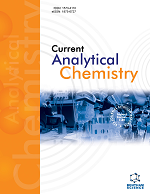- Home
- A-Z Publications
- Current Analytical Chemistry
- Previous Issues
- Volume 15, Issue 7, 2019
Current Analytical Chemistry - Volume 15, Issue 7, 2019
Volume 15, Issue 7, 2019
-
-
Electrochemically Fabricated Solid Phase Microextraction Fibers and Their Applications in Food, Environmental and Clinical Analysis
More LessAuthors: Levent Pelit, Füsun Pelit, Hasan Ertaş and Fatma N. ErtaşBackground: Designing an analytical methodology for complicated matrices, such as biological and environmental samples, is difficult since the sample preparation procedure is the most demanding step affecting the whole analytical process. Nowadays, this step has become more challenging by the legislations and environmental concerns since it is a prerequisite to eliminate or minimize the use of hazardous subst Read More
-
-
-
Innovative Configurations of Sample Preparation Techniques Applied in Bioanalytical Chemistry: A Review
More LessBackground: Recently, in all fields of analytical chemistry, increased attention has been paid to extraction procedures and instrumental methods, which are easily scalable and are able to automate in order to improve the “high-throughput” capability. Introduction: The main goal of these applications relates to an improvement of the precision in the quantitative analysis, reduction of different sources of errors, decrease th Read More
-
-
-
Applications of Green Chemistry Approaches in Environmental Analysis
More LessAuthors: Aslı E. Yayayürük and Onur YayayürükBackground: Green chemistry is the application of methodologies and techniques to reduce the use of hazardous substances, minimize waste generation and apply benign and cheap applications. Methods: In this article, the following issues were considered: greener solvents and reagents, miniaturization of analytical instrumentation, reagent-free methodologies, greening with automation, greener sample preparation meth Read More
-
-
-
Automated Post-Column Sample Manipulation Prior to Detection in Liquid Chromatography: A Review of Pharmaceutical and Bioanalytical Applications
More LessAuthors: Natalia Manousi and Constantinos K. ZacharisAutomated post-column sample manipulation is undoubtedly one of the most challenging approaches in liquid chromatography for the improvement of method selectivity and sensitivity. With the post-column analyte derivatization being the most-abundant approach approach of this category, other strategies typically comprise post-column infusion of internal standard or other reagents prior to mass spectrometric de Read More
-
-
-
EDXRF Spectrometry and Complementary Non-Destructive Analytical Techniques in the Archaeometric Study of Copper Artefacts
More LessAuthors: Christos S. Katsifas and George A. ZachariadisBackground: For more than a decade, Energy Dispersive X-Ray Fluorescence (EDXRF) spectrometry is the primary analytical technique in archaeometric research and especially in the study of ancient copper artefacts. EDXRF has established itself as the fundamental archaeometric analytical technique because of features like: the ability to analyze samples in a non destructive or non invasive way, no requirements fo Read More
-
-
-
Recent Trends in the Development of Green Microextraction Techniques for the Determination of Hazardous Organic Compounds in Wine
More LessAuthors: Natasa P. Kalogiouri and Victoria F. SamanidouBackground: The sample preparation is the most crucial step in the analytical method development. Taking this into account, it is easily understood why the domain of sample preparation prior to detection is rapidly developing. Following the modern trends towards the automation, miniaturization, simplification and minimization of organic solvents and sample volumes, green microextraction techniques witness rapid Read More
-
Volumes & issues
-
Volume 21 (2025)
-
Volume 20 (2024)
-
Volume 19 (2023)
-
Volume 18 (2022)
-
Volume 17 (2021)
-
Volume 16 (2020)
-
Volume 15 (2019)
-
Volume 14 (2018)
-
Volume 13 (2017)
-
Volume 12 (2016)
-
Volume 11 (2015)
-
Volume 10 (2014)
-
Volume 9 (2013)
-
Volume 8 (2012)
-
Volume 7 (2011)
-
Volume 6 (2010)
-
Volume 5 (2009)
-
Volume 4 (2008)
-
Volume 3 (2007)
-
Volume 2 (2006)
-
Volume 1 (2005)
Most Read This Month
Article
content/journals/cac
Journal
10
5
false
en


